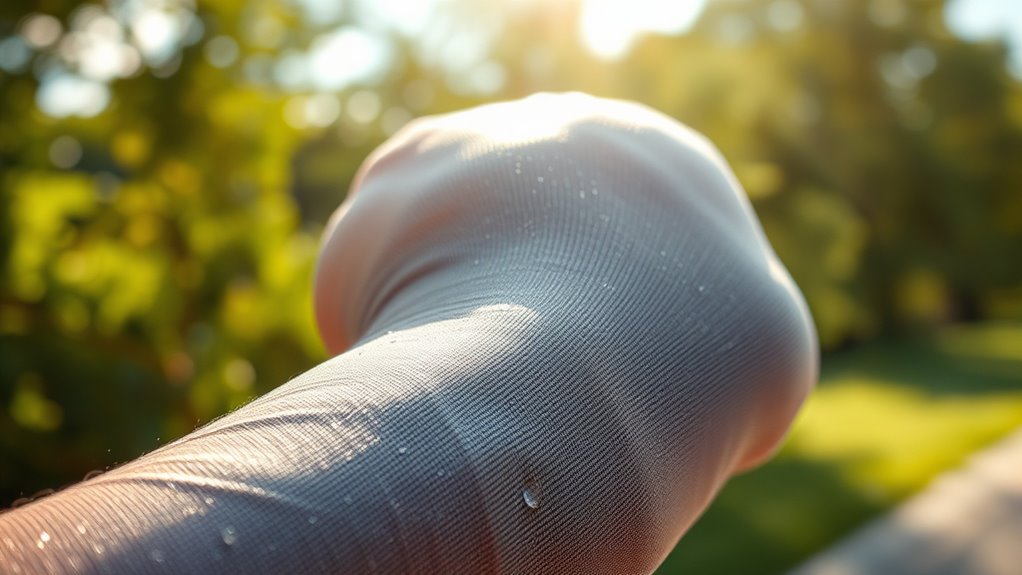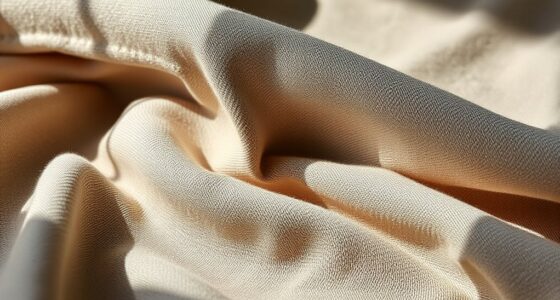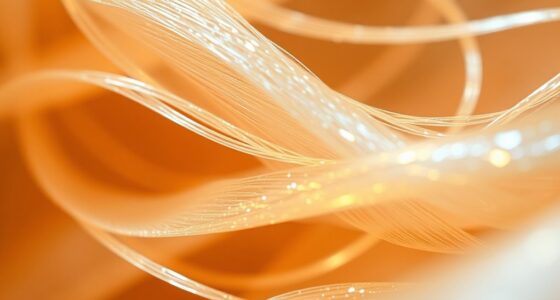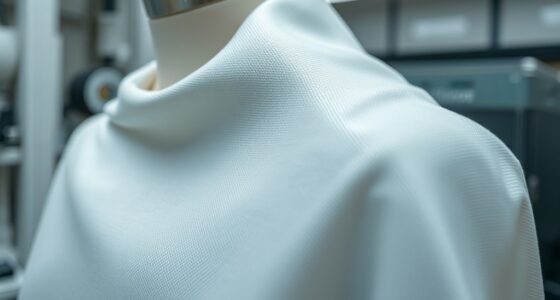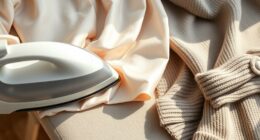Moisture-wicking fabrics keep you dry by actively pulling sweat away from your skin and moving it to the fabric’s outer surface. This allows the moisture to evaporate quickly, helping you stay comfortable during any activity. They also promote airflow, which helps regulate your body temperature and prevent overheating. If you want to understand how these textiles maximize breathability and performance, there’s more to explore below.
Key Takeaways
- Moisture-wicking fabrics pull sweat away from the skin to the outer surface of the material.
- They transport moisture quickly, enabling fast evaporation and keeping the skin dry.
- Enhanced breathability allows airflow, aiding in moisture evaporation and heat regulation.
- Synthetic fibers like polyester and nylon are commonly used for their durability and moisture management.
- Innovations aim to improve eco-friendliness while maintaining moisture-wicking performance.
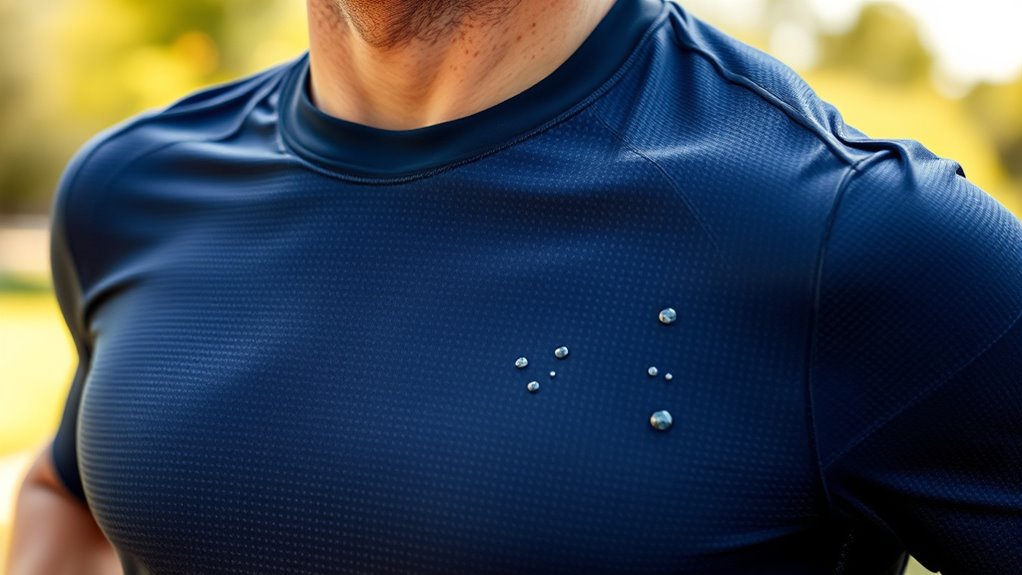
Moisture-wicking fabrics are designed to pull sweat away from your skin, keeping you dry and comfortable during physical activities. When you’re working out or engaging in outdoor sports, staying dry isn’t just about comfort; it’s also about maintaining your performance and preventing chafing. These fabrics excel at transporting moisture from your skin to the fabric’s outer surface, where it can evaporate quickly. This process maximizes breathability benefits, allowing air to circulate and moisture to escape more efficiently. As a result, you stay cooler and more comfortable, even during intense exercise.
Breathability isn’t just a comfort factor—it also plays a pivotal role in how well moisture-wicking fabrics perform over time. The better a fabric’s breathability, the more effectively it can manage sweat and heat, helping you avoid overheating. This is particularly important during prolonged physical activities or in hot environments, where heat buildup can become a serious issue. By promoting airflow and evaporation, moisture-wicking fabrics help regulate your body temperature, reducing fatigue and enhancing endurance.
Beyond comfort, these fabrics also have an environmental impact worth considering. Many moisture-wicking materials are made from synthetic fibers like polyester and nylon, which are durable and long-lasting, reducing the need for frequent replacements. This durability means less waste in landfills and fewer resources spent on manufacturing new garments. Furthermore, some brands are now developing eco-friendly moisture-wicking options using recycled plastics or sustainable fibers, aiming to lessen the environmental footprint. However, it’s important to recognize that synthetic fabrics can contribute to microplastic pollution when washed, shedding tiny fibers that escape into waterways. This issue has prompted ongoing research and innovation to develop biodegradable or more eco-conscious moisture-wicking textiles.
Frequently Asked Questions
Are Moisture-Wicking Fabrics Suitable for All Climates?
Yes, moisture-wicking fabrics are suitable for most climates because of their climate adaptability and fabric versatility. They keep you dry by pulling sweat away from your skin, which helps regulate your body temperature. Whether you’re in hot, humid weather or cooler environments, these fabrics perform well. They’re lightweight and breathable, making them a smart choice for various activities and conditions, ensuring comfort no matter where you are.
How Do Moisture-Wicking Fabrics Compare to Traditional Cotton?
You’ll notice that moisture-wicking fabrics outperform traditional cotton in breathability comparison, keeping you dry and comfortable longer. Surprisingly, they often cost less over time due to durability and less frequent washing needs. While cotton feels soft initially, moisture-wicking materials excel at quickly transporting sweat away from your skin, reducing chafing. So, when choosing between the two, consider both breathability and cost efficiency for your active lifestyle.
Can Moisture-Wicking Fabrics Be Recycled or Environmentally Friendly?
You might wonder if moisture-wicking fabrics are eco-friendly or recyclable. While some brands are developing innovative, eco-friendly options, recycling challenges remain due to synthetic fibers like polyester. Fortunately, eco-friendly innovations, such as biodegradable materials and recycling programs, are emerging. By choosing brands committed to sustainability, you help reduce environmental impact, making your activewear more eco-conscious and supporting a greener future.
Do Moisture-Wicking Fabrics Retain Odors Over Time?
Imagine wearing your moisture-wicking shirt after a long workout and noticing a faint odor retention. Yes, these fabrics can sometimes trap odors over time, especially if not washed properly. To maintain fabric freshness, wash your gear regularly with odor-fighting detergent, and avoid leaving it damp for too long. Proper care keeps your moisture-wicking fabrics smelling fresh and performing their best, mile after mile.
Are There Specific Care Instructions for Maintaining Moisture-Wicking Properties?
To maintain the moisture-wicking properties, follow proper washing techniques and consider fabric durability. Always wash your moisture-wicking clothes in cold water and avoid fabric softeners, which can clog the fibers. Use a gentle cycle and hang to dry or tumble dry on low. This care helps preserve the fabric’s ability to wick moisture, ensuring your gear stays effective and lasts longer.
Conclusion
So, next time you slip into that moisture-wicking shirt, imagine it’s a trusty sailboat cutting through choppy waters, whisking away sweat to keep you dry. These fabrics are your personal moisture superheroes, turning sweat into just a fleeting ripple on your surface. With them, you stay fresh and confident, even when the heat’s cranking up. Embrace these fabrics—they’re your secret armor against soggy, uncomfortable days, guiding you smoothly through any challenge.

